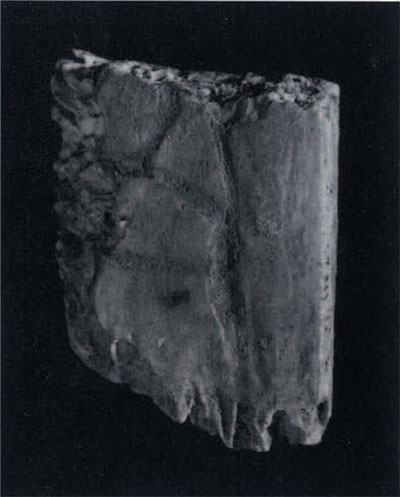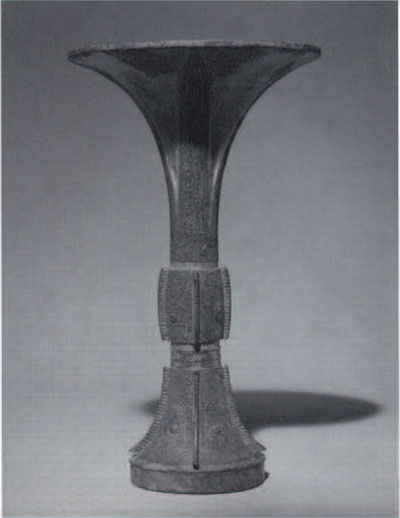
Late last summer (2000), when I returned to my office from a research trip to China, a message was waiting for me on my voice mail. It was from my colleague Erle Leichty, Clark Research Professor of Assyriology and Curator of Akkadian Languages and Literature at the University of Pennsylvania Museum. “Victor,” the message began, “this is Earle. I want you to come down to the tablet room and take a look at something we found in our collection. I think I know what it is, but I’d like you to verify that my hunch is right. And I believe you’ll be very interested in this object yourself.”
Needless to say, my curiosity was piqued, so I made an early appointment with Steve Tinney (Assistant Curator of the Babylonian Section) and Philip Jones (Research Specialist on the Sumerian Dictionary Project). When I entered the crowded room housing the tablet collection—their temporary quarters while construction of the Museum’s Mainwaring Wing is going on—Steve and Phil greeted me warmly. I told them that I had come to inspect a strange artifact that Earle had called to my attention. “Add, that one!” they said simultaneously and smiled. The piece seemed to have attained a certain notoriety in their section, so they located it fairly quickly.

A drawer was pulled out of one of the many cabinets in the room, and there I saw nestled amid the scores of brown cuneiform tablets a single cream-colored bone fragment. It was much smaller than the tablets and looked conspicuously out of place. As I held it in my hands and took a closer peek, I knew instantaneously that it was a Chinese oracle bone (Fig. I). I was completely confident of that judgment, for inscribed on its surface were eight or nine Chinese characters whose epigraphical form I recognized immediately as dating to approximately 1200 BCE.
These particular forms of the characters are known only from the latter part of the Shang period, that of China’s first historically verified dynasty (ca. 1700—ca. 1045 BCE). Furthermore, their use was restricted to the engraving of inscriptions on the surface of cattle bones (usually scapulae) and turtle plastrons. Diviners would submit questions to the deities concerning the weather, the welfare of various members of the royal family, warfare, crops, and so forth. They would then apply intense heat to the bones with a glowing metal rod, causing them to crack. Indeed, this process of divination is called bu (or *puk in archaic pronunciation), a word that is written with a graph depicting a pattern of cracks on a bone. Once the bones had cracked, the diviners could “read” the patterns, enabling them to interpret the answers of the deities.
Using a sharp tool, scribes recorded both the questions and the answers on the surface of the bones: these are the so-called oracle bone inscriptions. The Shang archives of divination texts. amounting to nearly 200,000 inscribed bones, were first discovered in the late 19th century. Chinese pharmacists prized the inscribed bones as potent ingredients for efficacious medicines. They would grind these “dragon bones” into a powder which they mixed in their potions and poultices. Once scholars realized the enormous importance of the bones, however, they began to collect them. Systematic excavations were carried out at the “Ruins of Yin” (Yinxu, Yin being another name for the Shang Dynasty, particularly its early period) near the city of Anyang in Henan Province, 280 miles southwest of Peking (Beijing). Over 95 percent of all oracle bones known today had been excavated by the year 1941.
There was little doubt that what had been found among the Museum’s cuneiform tablets appeared to be a genuine Shang Dynasty oracle bone. The main puzzles that confronted me next were how did it get there and what did the inscription on the bone say? For a moment, the tantalizing thought that a wandering Bronze Age merchant had carried it with him to Mesopotamia flashed through my mind. Just as swiftly, however, I dismissed the thought because of its sheer improbability and because assuredly the excavators, conservators, and scholars of the tablets would have long ago noticed that they had an ugly duckling on their hands. Most likely, the oracle bone had been mistakenly placed in a drawer full of cuneiform tablets after it had been brought out of Asian Section storage for some temporary exhibition dealing with the evolution of writing. I vaguely recall such an exhibition on writing that appeared in one of the Museum’s galleries a decade or so ago.


Furthermore, I noted that printed on the verso of this errant oracle bone was the following registration number: 55-34-7. Upon checking in the Museum’s records and archives, I learned that the part of the number before the slash revealed that the bone had once belonged to the Warner Collection at the Peabody Museum of Harvard University; the part of the number after the slash indicated that it had arrived at the University of Pennsylvania Museum in 1955. The bone was collected by Langdon Warner, a noted orientalist, in 1913-14 at Xiaotun, a village near Anyang. It was obtained from Harvard as part of an extended series of exchanges, lasting from 1955 to 1965, between Robert H. Dyson of the Museum and Lauriston Ward of the Peabody. Since these exchanges were designed to round out teaching collections of Near Eastern materials, it is remotely possible that the stray oracle bone came along accidentally from Harvard. Still, it is difficult to imagine how an item from the Warner Collection, which concentrated almost exclusively on East Asian and Central Asian materials, could have gotten mixed up with Southwest Asian materials at Harvard—unless it had been used for comparative teaching or exhibition purposes and not properly stored afterwards. Two more factors indicate that the confusion surrounding the bone occurred considerably after 1955. First, the object was clearly accurately identified as an oracle bone and duly registered when it entered the Museum in that year. Second, the cuneiform tablets of the Museum are in frequent use by Penn’s own scholars and by visitors from other institutions. It would have been very unlikely for the bone to go unnoticed in that drawer if it had lain there for nearly half a century. Even though the bone is relatively small, its unusual color and shape would have drawn the attention of virtually any researcher who consulted a tablet in the drawer where it lay. Consequently, I still hold to the theory that the bone was mistakenly placed in the tablet room drawer in the not-too-distant past after a short-term exhibition or teaching session.
During my investigations in the Museum, I was much impressed by the extraordinary care with which artifacts are treated and the meticulous records concerning them that are maintained by the curators, keepers, archivists, and registration personnel. Still, despite the best efforts of everyone and all of the mechanisms that are in place to prevent this sort of thing from happening, occasional slippage does occur. Considering that the Museum houses hundreds of thousands of objects and that they are much in demand for teaching, research, and exhibitions, it is remarkable how rarely objects get misplaced.


As to the meaning of the inscription on this fragment of bone, it roughly has to do with the sacrifice of two specially reared sheep (or perhaps bovines), ending (on the left side) with the familiar expression, “there will be no blame.” The eye at the end of the first line (on the bottom right), however, is so out of place (both graphically and linguistically) that one suspects it of having been added later by someone not entirely conversant with the language and script of oracle bone inscriptions. In fact, the first time I copied this inscription, I missed the eye completely and only spotted it the second time I read the inscription with a high-powered magnifying glass.
In investigating the oracle bone that had been recovered from the Babylonian Section, I discovered that the Museum holds four other oracle bones. They are the following: 49-14-7b, collected by Julia Morgan and given by her brother Hugh Morgan (Fig. 2); 49-14-7A, from the same source as the previous bone (Fig. 3); 65-2-9, acquired in an exchange from the Nelson Gallery of Art in Kansas City (Fig. 4); and 65-2-8, from the same source as the latter (Fig. 5). I list 65-2-8 last because it is quite obviously a fake (judging from its physical appearance and the writing on it), despite the fact that it has one well-formed graph (the first, top right, which is read liao in Modern Standard Mandarin and means “make a burnt offering”). On 65-2-9 there is a typical hunting inscription that means approximately “(We) should not hunt (at) Xiang (?), (for game) will not be caught.” The inscription on 49-14-7A reads “(X) may perhaps reach (such-and-such a place/person).” The half of a character still visible on 49-14-7b (which measures only 1.4 by 1 cm) is not enough even to guess at, so I shall make no attempt to do so.
The 1965 exchange with the Nelson Gallery brought the Museum a number of Shang Dynasty antiquities from Anyang that had been acquired in Peking. This was compensation for a pair of 6th century Chinese stone tomb doors which the Gallery had requested from Penn. In passing, I should say that all five of the oracle bones mentioned in this article left china before more recent restrictions on cultural material was put in place.
Concerning the identity of Julia Morgan or her connection with the Museum, I have so far not been able to determine anything.
While we may never be able reconstruct how oracle bone 55-34-7 ended up in a drawer of the tablet room, Professor Leichty has every right to be proud of himself for having recognized its true identity. He may be the only Assyriologist ever to have correctly identified an unlabeled Chinese oracle bone. As a Sinologist, I am delighted that he called me to assist in a more precise description of the fragment. Having now returned the bone to its proper place in the Museum’s collections, I and my colleagues in the Chinese program at the University now know that Penn holds not one, but five oracle bones!
Acknowledgments
I am grateful to Jennifer White (former Elizabeth Lyons Keeper of Asia Collections at UPM) for showing me four not-so-mysterious oracle bones in the Museum Collection and for making available the accession records for all the pieces mentioned in this article. Alex Pezzati, Interim Senior Archivist, provided additional information on the history of the oracle bones at the Museum. The following specialists assisted me in deciphering the inscriptions: Ken-ichi Takashima (University of British Columbia), Gilbert Mattos (Seton Hall), Edward Shaughnessy (University of Chicago), and David Keightley (University of California Berkeley). I alone an responsible for all errors of omission and commission.
